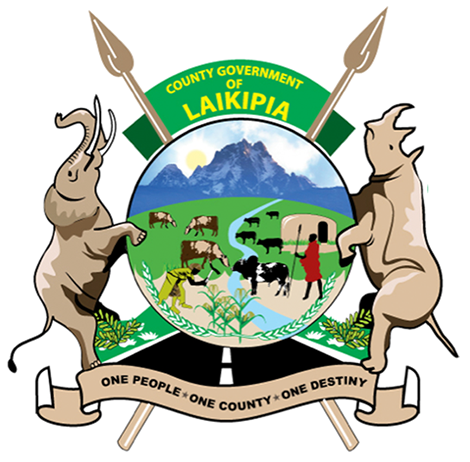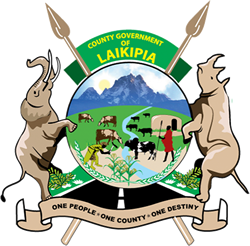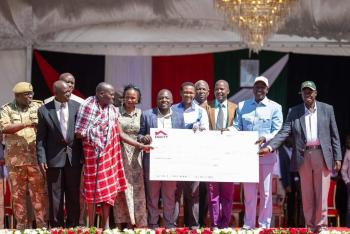The Laikipia UHC Model Works A Look At The NHIF Registration And Cover Utilisation At Nanyuki Teaching And Referral Hospital
Updated on: Jul 28, 2019
The County Government of Laikipia has prioritized the use of mass NHIF registration to achieve Universal Health Coverage (UHC). The registration which was accelerated through several waves of public campaigns, led at the highest leadership level, in collaboration with Amref Health Africa and NHIF, has seen over 50% of the population, at 274,273 members out of a projected population of 514,924 enrolled. This is according to Laikipia County Statistical Abstract of 2019.
The informal sector (the self-employed) was the major target for the recruitment drive and the major driver for Laikipia achieving the best social health insurance coverage, way above the national average of 36%. The registration process, using the M-Jali platform, identified 12,000 households eligible for a graduated subsidy scheme. Going by the average household size of four established by the latest Kenya Demographic and Health Survey, the subsidy will add another 48,000 members to the insurance bracket; pushing the insurance coverage to over 60% of the population.
Nanyuki Teaching and Referral Hospitals (NTRH) is among the health facilities that have benefitted from the increased insurance uptake. As a provider that has a contract with NHIF for the delivery of basic and specialised health services towards UHC, the number patients choosing the facility has steadily increased. In the just ended financial year 2018/2019, there has been a steadily growing NHIF outpatient capitation numbers signifying increasing public confidence in the hospital. The growth has seen NHIF insurance covered members increase from 34463, 36671, 39406 and 42411 in the first, second, third and fourth quarters respectively for the national cover only. By the beginning of this month, in the first quarter of the current 2019/2020 financial year, the number capitated had further grown to 43,205 members.
The numbers of NHIF members selecting NTRH as the primary health facility for accessing services have only been high in the recent times. At the beginning of the financial year 2015/2016, there were only 4,696 NHIF members capitated. By the financial year 2016/17, the numbers had risen to 17,486 NHIF members. In the first quarters of financial year 2017/2018, as the NHIF recruitment policy was underway, the numbers rose to 23,410; setting the hospital on the current trajectory.
The insured clients receive a wide array of specialised services at NTRH at no extra out of pocket payment. Patients and families have especially benefitted from renal dialysis, up two twice a week per family, which would have otherwise been unaffordable if cash payments were to be made to access the services. Quite a large range of radiology services will also be accessible to members. Patients have accessed planned surgery services as well through negotiated surgical packages.
We have observed that the high insurance cover penetration, and access to quality services by those covered, has resulted in further acceleration of NHIF coverage. Our statistics point out this unique patient behaviour. The NHIF-covered are a still a minority for the patients visiting NTRH for the first time. In the financial year 2018/2019, the NHIF-covered formed less than 50% (at 37%, 33%, 36% and 31% for the first, second, third and fourth quarters respectively). However, for revisits, the numbers of NHIF-covered patients have consistently been above 50%, and growing with each following quarter (at 53%, 56%, 61% and 61% respectively). While one may argue that the NHIF-covered patients have a different health seeking behaviour compared to the non-insured due to the removal of financial barriers to access; individual patients statistics show that a significant number of those who paid out of pocket in the initial visit accessed services through an insurance cover on a revisits.
Finally, we recorded a new trend that we consider was the turning point as far as Universal Health Coverage goals is concerned. For the first time in the history of the hospital, a majority of patients visiting the hospital were on a NHIF insurance cover. This trend was first seen in the third quarter, and was repeated in the last quarter of the year. It is important that the actual percentage (for sick patients) will be much higher. Our registration system, captures all visits, including some wellness visits that do not need a NHIF cover (free) or are not covered by insurance and must be paid in cash (like immunizations, medical and laboratory examination for schools or food handlers, medico-legal visits etc.). The importance of these observations and statistics can be national. We have already piloted successfully in our own way a UHC model that utilizes NHIF as its primary vehicle for implementation.
The Laikipia UHC model is supported by investments the County Government have made towards our quest for a Level-5 status. One of the most important infrastructural investments is the increase of the hospitals bed capacity from 180 to at least 300 beds which is a minimum requirement for a Level-5 hospital status. The County Government has prioritized this by constructing a 120-bed Maternal and Child wing. This, and further extension of existing wards will ensure the meeting of this bed-capacity target.
The informal sector (the self-employed) was the major target for the recruitment drive and the major driver for Laikipia achieving the best social health insurance coverage, way above the national average of 36%. The registration process, using the M-Jali platform, identified 12,000 households eligible for a graduated subsidy scheme. Going by the average household size of four established by the latest Kenya Demographic and Health Survey, the subsidy will add another 48,000 members to the insurance bracket; pushing the insurance coverage to over 60% of the population.
Nanyuki Teaching and Referral Hospitals (NTRH) is among the health facilities that have benefitted from the increased insurance uptake. As a provider that has a contract with NHIF for the delivery of basic and specialised health services towards UHC, the number patients choosing the facility has steadily increased. In the just ended financial year 2018/2019, there has been a steadily growing NHIF outpatient capitation numbers signifying increasing public confidence in the hospital. The growth has seen NHIF insurance covered members increase from 34463, 36671, 39406 and 42411 in the first, second, third and fourth quarters respectively for the national cover only. By the beginning of this month, in the first quarter of the current 2019/2020 financial year, the number capitated had further grown to 43,205 members.
The numbers of NHIF members selecting NTRH as the primary health facility for accessing services have only been high in the recent times. At the beginning of the financial year 2015/2016, there were only 4,696 NHIF members capitated. By the financial year 2016/17, the numbers had risen to 17,486 NHIF members. In the first quarters of financial year 2017/2018, as the NHIF recruitment policy was underway, the numbers rose to 23,410; setting the hospital on the current trajectory.
The insured clients receive a wide array of specialised services at NTRH at no extra out of pocket payment. Patients and families have especially benefitted from renal dialysis, up two twice a week per family, which would have otherwise been unaffordable if cash payments were to be made to access the services. Quite a large range of radiology services will also be accessible to members. Patients have accessed planned surgery services as well through negotiated surgical packages.
We have observed that the high insurance cover penetration, and access to quality services by those covered, has resulted in further acceleration of NHIF coverage. Our statistics point out this unique patient behaviour. The NHIF-covered are a still a minority for the patients visiting NTRH for the first time. In the financial year 2018/2019, the NHIF-covered formed less than 50% (at 37%, 33%, 36% and 31% for the first, second, third and fourth quarters respectively). However, for revisits, the numbers of NHIF-covered patients have consistently been above 50%, and growing with each following quarter (at 53%, 56%, 61% and 61% respectively). While one may argue that the NHIF-covered patients have a different health seeking behaviour compared to the non-insured due to the removal of financial barriers to access; individual patients statistics show that a significant number of those who paid out of pocket in the initial visit accessed services through an insurance cover on a revisits.
Finally, we recorded a new trend that we consider was the turning point as far as Universal Health Coverage goals is concerned. For the first time in the history of the hospital, a majority of patients visiting the hospital were on a NHIF insurance cover. This trend was first seen in the third quarter, and was repeated in the last quarter of the year. It is important that the actual percentage (for sick patients) will be much higher. Our registration system, captures all visits, including some wellness visits that do not need a NHIF cover (free) or are not covered by insurance and must be paid in cash (like immunizations, medical and laboratory examination for schools or food handlers, medico-legal visits etc.). The importance of these observations and statistics can be national. We have already piloted successfully in our own way a UHC model that utilizes NHIF as its primary vehicle for implementation.
The Laikipia UHC model is supported by investments the County Government have made towards our quest for a Level-5 status. One of the most important infrastructural investments is the increase of the hospitals bed capacity from 180 to at least 300 beds which is a minimum requirement for a Level-5 hospital status. The County Government has prioritized this by constructing a 120-bed Maternal and Child wing. This, and further extension of existing wards will ensure the meeting of this bed-capacity target.



